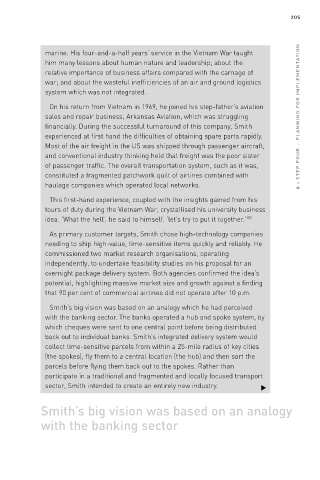Page 228 - DNBI_A01.QXD
P. 228
2056 : STEP FOUR – PLANNING FOR IMPLEMENTATION
Mmarine. His four-and-a-half years’ service in the Vietnam War taught
him many lessons about human nature and leadership; about the
relative importance of business affairs compared with the carnage of
war; and about the wasteful inefficiencies of an air and ground logistics
system which was not integrated.
On his return from Vietnam in 1969, he joined his step-father’s aviation
sales and repair business, Arkansas Aviation, which was struggling
financially. During the successful turnaround of this company, Smith
experienced at first hand the difficulties of obtaining spare parts rapidly.
Most of the air freight in the US was shipped through passenger aircraft,
and conventional industry thinking held that freight was the poor sister
of passenger traffic. The overall transportation system, such as it was,
constituted a fragmented patchwork quilt of airlines combined with
haulage companies which operated local networks.
This first-hand experience, coupled with the insights gained from his
tours of duty during the Vietnam War, crystallised his university business
idea. ‘What the hell’, he said to himself, ‘let’s try to put it together.’155
As primary customer targets, Smith chose high-technology companies
needing to ship high-value, time-sensitive items quickly and reliably. He
commissioned two market research organisations, operating
independently, to undertake feasibility studies on his proposal for an
overnight package delivery system. Both agencies confirmed the idea’s
potential, highlighting massive market size and growth against a finding
that 90 per cent of commercial airlines did not operate after 10 p.m.
Smith’s big vision was based on an analogy which he had perceived
with the banking sector. The banks operated a hub and spoke system, by
which cheques were sent to one central point before being distributed
back out to individual banks. Smith’s integrated delivery system would
collect time-sensitive parcels from within a 25-mile radius of key cities
(the spokes), fly them to a central location (the hub) and then sort the
parcels before flying them back out to the spokes. Rather than
participate in a traditional and fragmented and locally focused transport
sector, Smith intended to create an entirely new industry.
Smith’s big vision was based on an analogy
with the banking sector

